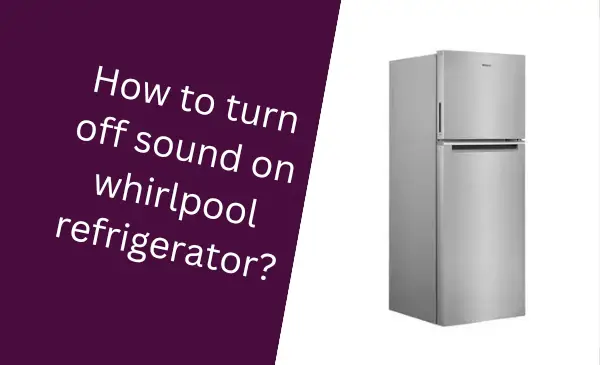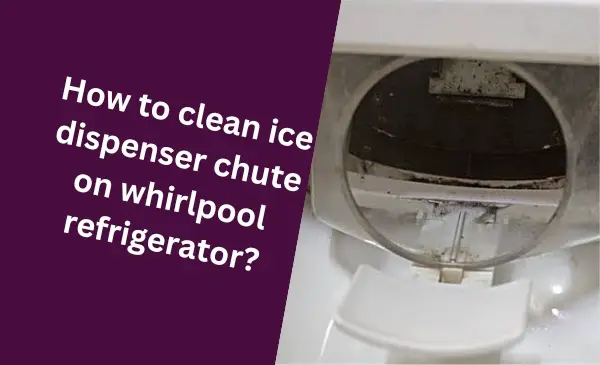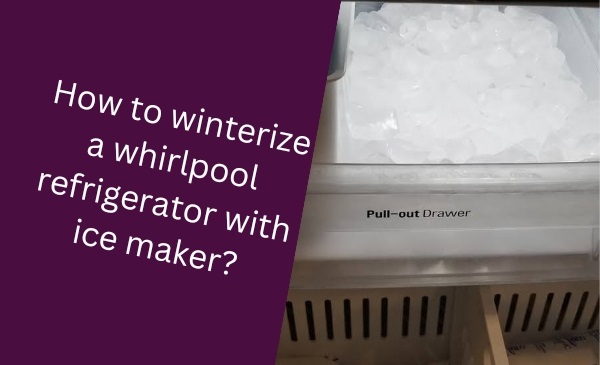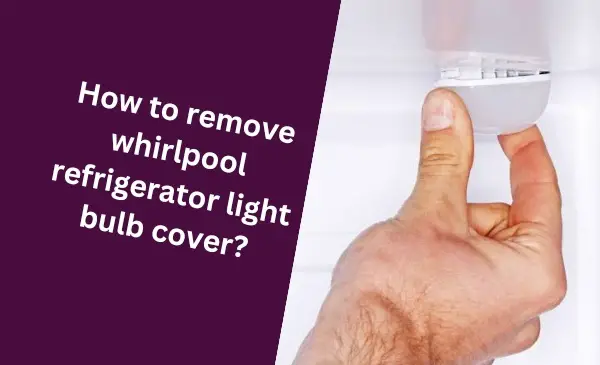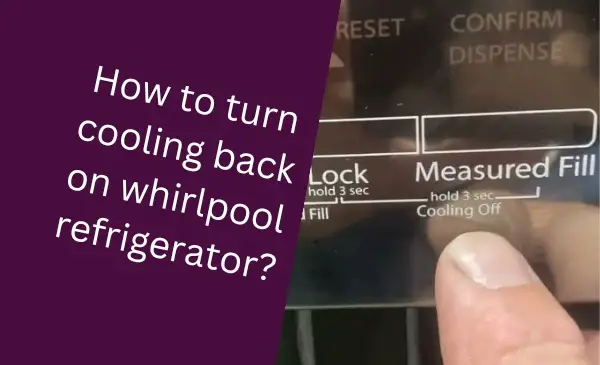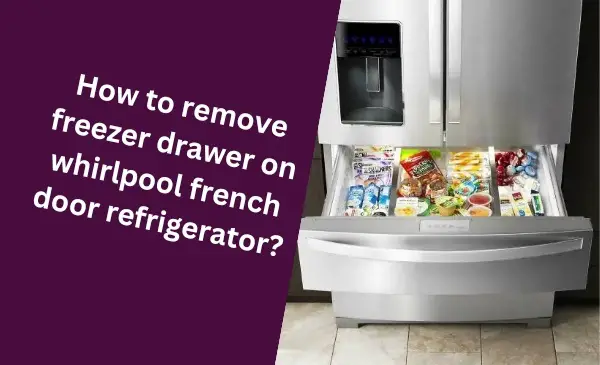Is your Whirlpool refrigerator covered in frost? If so, it’s time to defrost it. Defrosting your refrigerator regularly will help it run more efficiently and keep your food fresher.
Frost can build up in your refrigerator over time, especially if you open and close the door frequently. This frost can block the airflow in your refrigerator, making it less efficient. It can also make it difficult to see your food, and it can even cause the food to spoil more quickly.
In this article, we’ll show you how to defrost your Whirlpool refrigerator safely and easily. We’ll cover everything you need to know, from the tools you need to the steps involved.
Understand The Need For Regular Defrosting
Before you dive into the step-by-step guide, you need to understand the need for regular defrosting. In this section, we just explain this.
So, Let’s go!
Why Is Defrosting Important For Your Whirlpool Refrigerator?
Regular defrosting is a crucial aspect of maintaining the efficiency and longevity of your Whirlpool refrigerator. Let’s dig deeper into why defrosting is essential for your appliance’s optimal performance. The cooling process in a refrigerator produces frost or ice buildup on the evaporator coils over time.
If left unattended, this frost can hamper the refrigerator’s functionality and lead to various issues. By understanding the significance of regular defrosting, you can ensure that your Whirlpool refrigerator remains in top shape.
The Benefits Of Regular Defrosting
There are numerous benefits to be gained from regularly defrosting your Whirlpool refrigerator.
Let’s explore some of the key advantages:
1. Enhanced Energy Efficiency
When ice accumulates on the evaporator coils, it acts as an insulating barrier, preventing the efficient transfer of cool air to the stored food items. This causes the refrigerator to work harder to maintain the desired temperature, resulting in increased energy consumption.
By defrosting your Whirlpool refrigerator regularly, you can remove this ice buildup and restore the appliance’s energy efficiency.
2. Extended Lifespan
Ice accumulation not only affects the refrigerator’s cooling efficiency but also poses a risk of long-term damage to vital components such as the evaporator coils and the compressor. Regular defrosting helps prevent wear and tear on these components, extending the lifespan of your Whirlpool refrigerator.
3. Optimal Storage Capacity
Ice buildup reduces the usable space inside your refrigerator, limiting your storage capacity. As the ice takes up valuable room, it becomes challenging to organize and fit all your food items conveniently. Through regular defrosting, you can reclaim the lost storage space, providing you with ample room to store your groceries and leftovers.
4. Improved Food Preservation
Ice crystals that form on frozen food items during the defrosting process can lead to freezer burn, ultimately affecting the quality and taste of your stored food. By defrosting your Whirlpool refrigerator at regular intervals, you minimize the risk of freezer burn, ensuring that your food items stay fresh and delicious for longer.
5. Prevents Unpleasant Odors
Moisture from the melted ice can accumulate and lead to unpleasant odors inside the refrigerator. Regular defrosting helps remove any lingering odors, creating a fresh and clean environment for your stored food items.
By understanding the need for regular defrosting and recognizing the benefits it offers, you can take proactive steps to ensure that your Whirlpool refrigerator functions optimally. Don’t forget to schedule regular defrosting sessions to maintain the efficiency and longevity of your appliance.
Preparing Your Whirlpool Refrigerator For Defrosting
If you own a Whirlpool refrigerator, you know how important it is to regularly defrost it to maintain its efficiency and prolong its lifespan. Defrosting your refrigerator ensures that it operates at its best, preventing ice buildup that can affect its performance.
In this section, we will guide you through the steps of preparing your Whirlpool refrigerator for defrosting, ensuring a smooth and hassle-free process.
Gather The Necessary Supplies For Defrosting
Before you embark on the defrosting process, it is essential to gather all the necessary supplies. By having everything ready, you can save time and avoid interruptions during the defrosting process. Here is a list of items you will need:
| Supplies |
|---|
|
Safely Remove All Food Items From The Refrigerator
The next step in preparing your Whirlpool refrigerator for defrosting is to safely remove all food items. Start by checking the expiration dates of your perishable foods and discard anything that has gone bad. Transfer the remaining items to a cooler or insulated bags to keep them fresh during the defrosting process. This step is crucial to prevent food spoilage and ensure that your refrigerator stays clean and sanitary.
Unplug The Refrigerator To Ensure Safety During The Defrosting Process
Before you can start defrosting your Whirlpool refrigerator, it is important to unplug it from the power source. This step ensures your safety while handling the refrigerator and prevents any potential electrical accidents. Take a moment to locate the power cord at the back of the refrigerator and unplug it from the socket. Once the refrigerator is unplugged, you can proceed with the defrosting process without any worries.
Step-by-step Guide To Defrosting Your Whirlpool Refrigerator
Here is the step-by-step guide to defrosting your Whirlpool Refrigerator.
Emptying And Cleaning The Freezer Compartment
If you’re dealing with an ice-clogged Whirlpool refrigerator, the first step is to empty and clean the freezer compartment. Start by removing all the frozen foods and placing them in a cooler with ice packs to keep them cold during the defrosting process. Make sure to label the packages with the contents and date to ensure food safety.
Next, unplug the refrigerator for safety reasons. While it is defrosting, you don’t want it to accidentally turn on and cause any accidents.
Once the freezer is empty and the refrigerator is unplugged, take this opportunity to give the compartment a thorough cleaning. Use a mixture of mild dish soap and warm water to wipe down the interior surfaces. Pay special attention to any hardened ice or food residue. After cleaning, rinse with a damp cloth and dry the surfaces carefully to prevent any potential damage.
Using Hot Water Or A Hairdryer To Melt The Ice Build-up
Now that the freezer compartment is clean, it’s time to tackle the ice build-up. There are two common methods to expedite the melting process: using hot water or a hairdryer.
If you opt to use hot water, fill a bowl or a container with hot tap water, but ensure it’s not too hot to handle. Place the container in the freezer and close the door. Avoid using boiling or scalding water as it may cause damage to the freezer components. Keep a close eye on the water level, replenishing it as necessary until the ice has melted away.
Alternatively, using a hairdryer is another effective option. Set the hairdryer to a low or medium heat setting, and direct the warm airflow onto the ice buildup. Be cautious not to aim the hot air towards any plastic components for an extended period to avoid melting or warping. Move the hairdryer back and forth, maintaining a distance of at least six inches from the ice. As the ice melts, use a towel or a sponge to soak up the excess water.
Removing Excess Water And Drying The Compartments
After successfully melting and removing the ice buildup, it’s crucial to remove any excess water and dry the compartments thoroughly to prevent future issues.
Start by using a sponge or a towel to soak up any remaining water in the freezer compartment. Wring it out as needed to ensure maximum absorption. Pay extra attention to the corners and crevices, as water tends to accumulate there.
Once the excess water is removed, leave the freezer compartment open and let it air dry for a few hours. Avoid using any heat sources to accelerate the drying process, as this may cause damage to the refrigerator.
Cleaning The Refrigerator Interior After Defrosting
After the freezer compartment is thoroughly defrosted and dried, it’s time to clean the refrigerator’s interior. Start by removing all the shelving, drawers, and other removable components.
Prepare a solution of mild dish soap and warm water in a basin or a sink. Take care not to immerse electrical parts in water. Soak the removable pieces in the solution and scrub them gently using a sponge or a soft cloth. Rinse each piece thoroughly and dry them before placing them back into the refrigerator.
Using the same solution, wipe down the interior surfaces of the refrigerator, including the walls, shelves, and door seals. Ensure all food debris and spills are carefully removed to maintain hygiene. Rinse the surfaces with a damp cloth and dry them thoroughly to prevent any lingering moisture.
Safety Tips And Precautions For Defrosting
Defrosting your Whirlpool refrigerator is an essential maintenance task to ensure its optimal performance. However, it is important to follow certain safety tips and precautions to prevent any damage to your refrigerator and to ensure your own safety during the defrosting process.
In this section, we will discuss how to prevent damage to your refrigerator, ensure proper ventilation to avoid odors and handle and dispose of melted ice and water safely.
How To Prevent Damage To Your Refrigerator During The Defrosting Process
During the defrosting process, it is crucial to take precautions to prevent any damage to your refrigerator. Here are some tips to follow:
- Unplug the refrigerator: Before starting the defrosting process, make sure to unplug the refrigerator from the power source. This will ensure your safety and prevent any electrical mishaps.
- Remove all food items: Take out all the food items from your refrigerator and store them in a cool place to prevent them from spoiling during the defrosting process. You can use cooler bags or insulated containers to keep the food fresh.
- Allow natural defrosting: Avoid using sharp objects or tools to speed up the defrosting process, as this can damage the interior of your refrigerator. Instead, allow the ice to melt naturally.
- Clean the interior: Once the ice has melted, clean the interior of your refrigerator using a mild detergent and warm water. Make sure to dry it thoroughly before plugging it back in.
Ensuring Proper Ventilation During Defrosting To Avoid Odors
Proper ventilation is important during the defrosting process to avoid any unpleasant odors that may linger in your refrigerator. Here’s how you can ensure proper ventilation:
- Open the doors: Keep the refrigerator doors open while defrosting to allow proper air circulation. This will help in eliminating any bad odors that may develop during the process.
- Use baking soda: To further eliminate any remaining odors, place an open box of baking soda inside your refrigerator. Baking soda absorbs odors and helps in keeping your refrigerator smelling fresh.
- Regularly clean the drain pan: The drain pan at the bottom of your refrigerator can accumulate water and debris over time, leading to unwanted odors. Clean the drain pan regularly to prevent any unpleasant smells.
Handling And Disposing Of Melted Ice And Water Safely
While defrosting your Whirlpool refrigerator, you will encounter melted ice and water that need to be handled and disposed of safely. Here are the steps to follow:
- Collect the water: Place a large container or tray beneath the refrigerator to catch the melted water. This will prevent any water damage to your surroundings.
- Dispose of the water responsibly: Once the water has been collected, dispose of it responsibly. You can pour it down the sink or use it for watering plants, as long as it’s free from any chemical contaminants.
- Clean the container: After disposing of the water, clean the container or tray thoroughly to remove any residue. This will ensure it is ready to be reused for future defrosting.
By following these safety tips and precautions, you can defrost your Whirlpool refrigerator effectively and prevent any damage or safety hazards. Remember to always prioritize your safety and the well-being of your refrigerator to ensure its longevity and optimal operation.
Maintaining A Defrosting Schedule
One of the key aspects of keeping your Whirlpool refrigerator in top-notch condition is maintaining a regular defrosting schedule. Over time, ice can build up in the freezer compartment, leading to decreased efficiency and potential damage to the appliance. By following a consistent defrosting routine, you can ensure optimal performance and extend the lifespan of your refrigerator.
In this section, we will discuss how often you should defrost your Whirlpool refrigerator, offer tips for keeping track of your defrosting schedule, and provide advice on preventing ice buildup to reduce the frequency of defrosting.
How Often Should You Defrost Your Whirlpool Refrigerator?
Scheduling regular defrosting sessions for your Whirlpool refrigerator is essential to maintain its efficiency and functionality. However, the frequency of defrosting may vary depending on factors such as usage, climate conditions, and the model of your refrigerator.
As a general guideline, it is recommended to defrost your Whirlpool refrigerator every six months to one year. This timeframe allows for proper removal of ice buildup without excessive damage or inconvenience.
Tips For Keeping Track Of Your Defrosting Schedule
Keeping track of your defrosting schedule ensures timely maintenance and keeps your refrigerator running smoothly. Here are some simple yet effective tips to help you stay organized:
- Create a reminder: Set a reminder on your calendar, phone, or any other digital device to alert you when it’s time to defrost your refrigerator. Choose a date that is convenient for you and suits your schedule.
- Make a note on the refrigerator: Stick a small note or a magnetic whiteboard on your refrigerator’s door to remind you about the upcoming defrosting session. Having a visual reminder in a prominent location can help you stay proactive and prevent any unnecessary delays.
- Use a defrosting log: Maintain a dedicated defrosting log where you can record the dates of your previous defrosting sessions. This log will not only help you track your schedule but also give you an overview of the frequency at which you defrost your Whirlpool refrigerator.
- Set recurring reminders: If you prefer a digital solution, use task management or calendar apps that allow you to set recurring reminders. This way, you won’t have to manually enter the defrosting dates each time, as the app will automatically remind you based on your preferred schedule.
Preventing Ice Build-up To Reduce The Frequency Of Defrosting
In addition to following a regular defrosting schedule, it’s important to take preventive measures to reduce ice build-up in the first place. By minimizing ice accumulation, you can decrease the frequency of defrosting sessions. Here are some practical tips:
- Check door seals: Regularly inspect the door seals of your Whirlpool refrigerator to ensure they are clean and properly sealed. Damaged or loose seals can allow warm air to enter, leading to increased condensation and ice formation. If any seals are faulty, consider replacing them promptly.
- Avoid overfilling: Be mindful of not overfilling your refrigerator or freezer compartments. Overloading these spaces can obstruct proper airflow, leading to uneven cooling and ice buildup. Utilize storage organizers and arrange items in an organized manner to maintain optimal airflow.
- Keep temperature settings appropriate: Ensure that your refrigerator and freezer temperature settings are at the recommended levels. Too low temperatures can cause excessive condensation, while too high temperatures can hinder proper cooling. Refer to the user manual or manufacturer’s guidelines to set the ideal temperature settings for your specific Whirlpool refrigerator model.
- Clean the interior regularly: Regularly clean the interior of your refrigerator, paying extra attention to any spills or food debris. Proper cleanliness helps prevent unnecessary moisture and ice accumulation. Empty the refrigerator before defrosting to avoid any damage during the process.
By following these handy tips, you can maintain a healthy defrosting schedule for your Whirlpool refrigerator and enjoy its optimal performance for years to come. Remember, regular defrosting and preventive measures go hand in hand to keep your appliance running efficiently and extend its lifespan.
:max_bytes(150000):strip_icc()/refrigerator-crisper-drawers-whirlpool-2-0717-horiz-dbd7fb12459f4aaa960270358a2a20a2.jpg)
Credit: www.marthastewart.com
Frequently Asked Questions Of How To Defrost A Whirlpool Refrigerator
How Often Should I Defrost My Whirlpool Refrigerator?
It is recommended to defrost your Whirlpool refrigerator at least once every six months to ensure optimal performance and energy efficiency. However, you may need to defrost more frequently if you notice a buildup of ice or frost inside the freezer compartment.
Can I Defrost My Whirlpool Refrigerator Without Turning It Off?
Yes, you can defrost your Whirlpool refrigerator without turning it off. Simply unplug the refrigerator, remove all food and freezer items, and use a hairdryer or hot water to melt the ice buildup. Be careful not to use sharp objects to scrape away the ice, as it can damage the interior surfaces.
What Is The Quickest Way To Defrost A Whirlpool Refrigerator?
The quickest way to defrost a Whirlpool refrigerator is to use a hairdryer. Set the hairdryer to a low heat setting and aim it at the ice buildup inside the freezer compartment. Move the hairdryer in a sweeping motion, melting the ice in small sections.
Be sure to keep the hairdryer a safe distance away from any water or moisture.
Can I Use A Knife To Remove Ice From My Whirlpool Refrigerator?
No, it is not recommended to use a knife or any sharp object to remove ice from your Whirlpool refrigerator. Doing so can scratch and damage the interior surfaces. Instead, use a hairdryer on a low heat setting or pour hot water over the ice to melt it away gently.
Conclusion
Defrosting a Whirlpool refrigerator is a simple process that can help improve its efficiency and performance. By following the steps outlined in this post, you can effectively remove excess ice buildup and restore optimal functioning to your appliance. Remember to always unplug the refrigerator and use gentle methods to avoid damaging the equipment.
Regularly defrosting your refrigerator will not only extend its lifespan but also ensure that your food stays fresh and your energy bills stay low.
Hello Readers, I am Mechanic Shuvo, a seasoned refrigerator solution expert with over 11 years of hands-on experience in the field. Throughout my career, I've dedicated myself to understanding the ins and outs of refrigeration systems, honing my skills as a refrigerator mechanic. My passion for these appliances led me to create the website "refrigeratorsolutionsguide.com," where I aim to share my wealth of knowledge and expertise with others.
Over the years, I've encountered a wide range of refrigerator issues and have successfully resolved them all. From common problems like temperature fluctuations and strange noises to more complex technical issues, I've seen it all. Through my website, I hope to provide practical solutions, insightful tips, and guidance to help you keep your refrigerators running smoothly.


